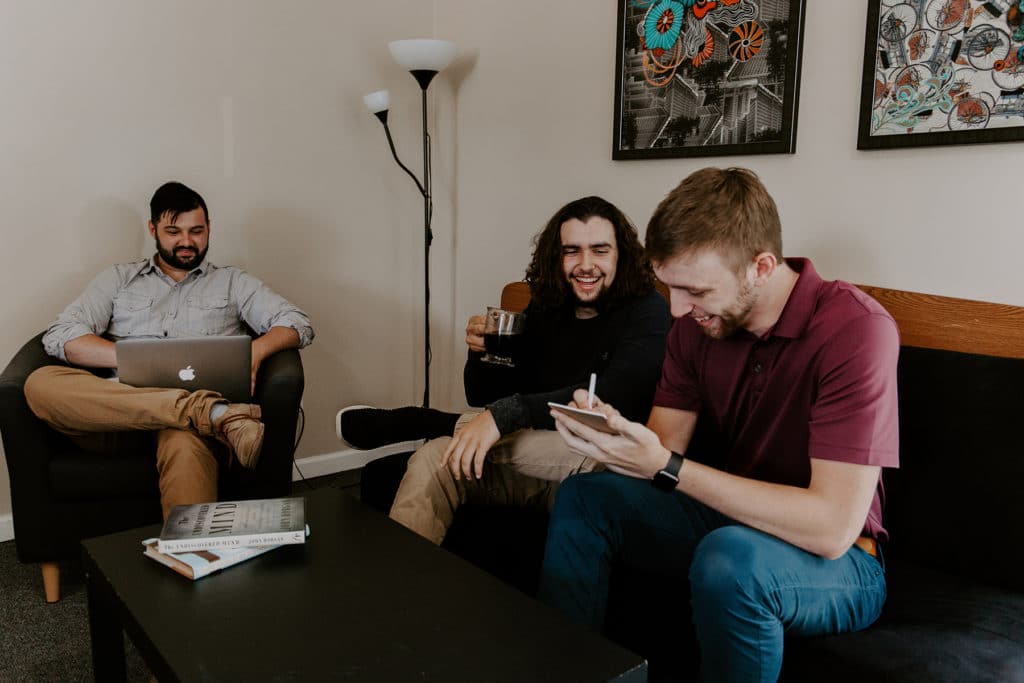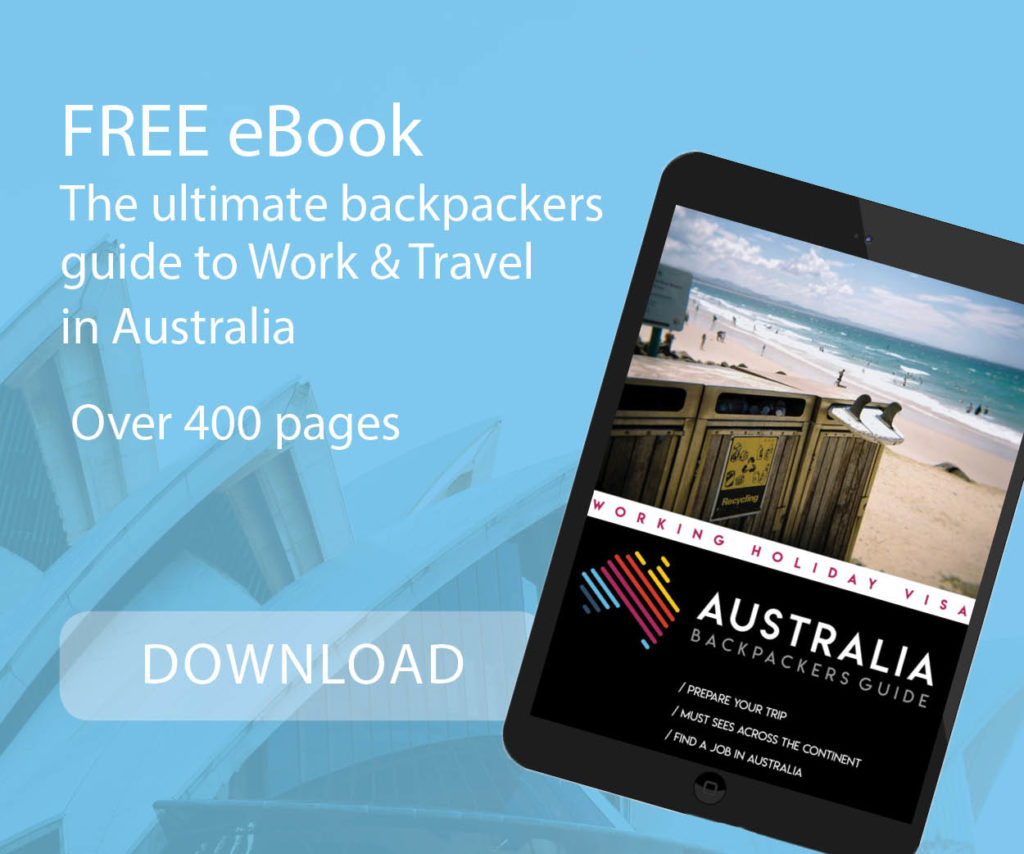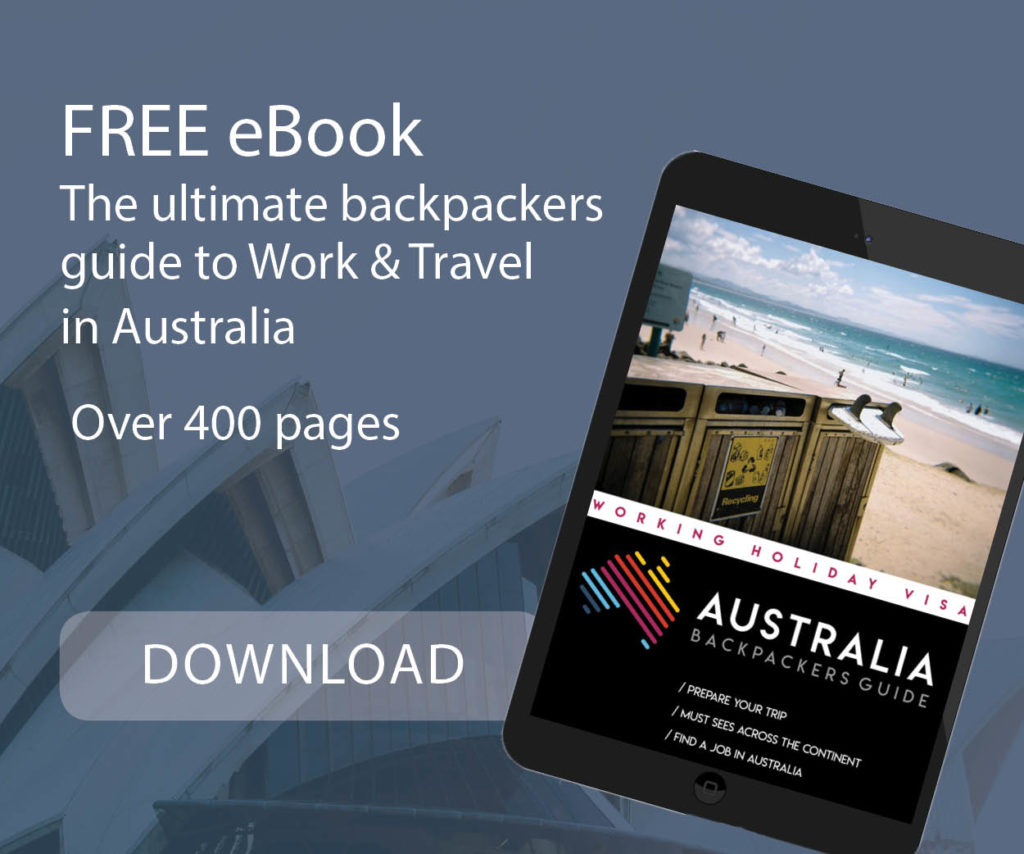You’ve been thinking about it for a while, and now you’ve finally made your decision – you’re heading to Australia! Whether you’re planning a short holiday or hope to stay for at least a few months/years on a Working Holiday Visa, a trip Down Under requires planning and preparation. To help you out, here are the first steps to take when you arrive in Australia.
Table of Contents
Formalities to enter Australia in 2024
Your first contact with Australia will most likely be at the airport. When you get off the plane, you will have to collect your luggage and go through customs. Here are the requirements to enter Australia:
A valid visa
To enter Australia, you absolutely must have a valid visa. If you are only going on a short trip and don’t plan to work in the country, go for a Tourist visa (3 months). If you want to study in Australia, then a Student visa is what you need. If you plan to work and/or go on a longer road trip around Australia, opt for a Working Holiday Visa.
Visa applications can be made online, only on the Australian immigration website.
Your visa will be electronic and linked to your passport, and will be checked by Australian immigration when you arrive in the country.
A valid passport
To apply for a visa for Australia, it is necessary to have a valid passport. Check that it is valid for at least 6 months after your return date. If not, renew it before you leave. It takes a long time to obtain, so take the necessary steps as soon as possible.
Customs clearance process
First, you will need to present your passport to the Border Police officers. If you have a biometric passport, this check can be carried out through an automatic airlock (passport scan, facial recognition), allowing you to get through faster. Since your visa is linked to your passport, the authorities ensure that you have the right to be in Australia.
After that, you will have to pass a second check, where you will present your Incoming Passenger Card. This declaration form is usually given to you on the plane, and contains details of any items like fresh food or large amounts of cash that you have may have brought with you. A biosecurity officer will check any declared items, ask you questions and ensure that the items comply with customs regulations. Items may be confiscated. Before your arrival in Australia, it is important to check customs regulations, especially concerning the import of food. Make sure to declare everything to avoid getting fined.
Read also : Customs in Australia

Health Insurance
Some countries, such as Switzerland, Italy and the UK, have signed reciprocal health agreements with Australia. Their nationals can therefore partially benefit from the Australian health system. Beware, however, that the coverage offered is much less than that enjoyed by Australians themselves. Indeed, only essential care will be covered.
Given that medical care is very expensive, it is highly recommended to get health insurance for your trip to Australia. Whether you are going on vacation, studying, or on a Working Holiday Visa, make sure you are well covered.

Vaccinations and Importations
While Australia does not pose any major health risks, it is advisable to check and update your basic vaccinations before departure, such as diphtheria, tetanus, whooping cough, polio, measles, mumps, and rubella. Also, consider hepatitis vaccines, and certain vaccines like typhoid or rabies if you plan to stay in rural areas where food hygiene might be poor. Regarding Covid, no proof of vaccination is required to enter the country.
Australia has strict rules regarding the importation of food, plants, and animal products to prevent the spread of diseases and pests. It’s important to abide by these rules and declare all potentially prohibited items upon arrival. This declaration is made on the Incoming Passenger Card (mentioned above).
Driving licence
To drive in Australia, whether you are leasing a vehicle or buying one, you will need an international licence or a NAATI translation of your national licence if your licence is not in English. If you apply for an international licence, you should be aware that it usually takes a long time to get it. The procedure should therefore be planned well in advance. If you haven’t had time to do this before you leave, don’t panic! You can have your driving licence translated by approved NAATI translators. This takes between 24 and 48 hours and is a paying service.
Getting to your accommodation from the airport
Once you’re past the initial formalities at the airport, it’s time to go to your accommodation. Depending on your city of arrival, you can choose to take a train (underground), a bus, or a taxi/Uber. Some hostels and hotels offer a free shuttle bus from the airport, so make sure you check this before your arrival!
As an example, Sydney Airport is located just 13 minutes by train from the city. The Airport Link shuttle offers a quick way to reach the city, with trains running every 10 minutes, priced at around $20. A taxi will take about 20 minutes and will cost you around $50 (around $40 if you get an Uber). To reach the city via public transport, you will need to take two buses (about $10 total) and it will be about a 90-minute trip.
For Melbourne, the SkyBus is an express shuttle service that connects the airport to Southern Cross bus station in the city centre. Buses run every 10-15 minutes and the trip takes around 30 minutes (approximately $25). You can also take the bus, which will cost you around $15 but takes 50 minutes. Finally, a taxi or Uber will take you to the city centre in 20-30 minutes. Budget about $45 for a taxi and $35 for an Uber.
Get a phone plan and Internet access
One of the first things you will need when you arrive in Australia is a phone number and internet access. If your current phone plan can be useful the first few days, it is strongly recommended to take out an Australian mobile plan.
Have an Australian phone number
Whether it is to find accommodation, work or even sometimes to open a bank account, an Australian phone number is very useful.
The easiest thing to do when you arrive is to buy a prepaid Sim card (usually $2). You can then recharge it whenever you want. You will even find some for sale at the airport. As for mobile networks, this will depend on your travel plans. If you’re staying in cities, go for the cheapest. On the other hand, if you’re going on a road trip, choose Telstra, which offers the best national coverage.
Access the Internet
It’s always a good idea to make sure data is included in your phone plan, but if you don’t have data, WiFi is quite widespread in Australia. You will usually find free Internet access:
- In large cities, most with accessible Wi-Fi in public spaces
- In some cafes and restaurants (McDonald’s, Starbucks etc)
- Public Libraries
- At malls and shopping centres
- At youth hostels or where you are staying (campsite, hotel, motel).
Buy a transport card
Australia is huge, and not always easy to get around. Jumping in a taxi or an Uber is fine on a shorter trip, but the cost can easily add up over time. Unless you have enough money to buy a car, look into buying a transport card for your city of arrival. These cards allow you to save money when travelling by bus, train, tram, metro, ferry and sometimes even bicycle!
- In Sydney: the Opal card
- In Brisbane/Sunshine Coast/Gold Coast: the Go card
- In Melbourne: the Myki
- In Perth: the SmartRyder card
- In Adelaide: the Metrocard
Find accommodation
Temporary accommodations
One of the most important things you will have to do when you arrive in Australia is finding accommodation. To give you a few days or a week to get your bearings, it’s a good idea to stay in a hostel (Backpackers Hostel) if you’re on a smaller budget. Prices can range from $50 to $80 for one night. It all depends on the location, the type of room and the time of year.
For accommodation in Sydney or Melbourne, for example, expect to pay a minimum of $50 per night for a bed in a dormitory, and $90 for a private room (if you book in advance). In high season, these rates can increase by 50% to 70%!
Although there are loads of hostels in the major Australian cities, it’s recommended to make a reservation before your arrival. You will generally get better rates if you stay longer than one week.
Compare hostels
To find the hostel that best meets your needs, use Booking.com. It’s very thorough and the reviews are always honest!
For short stays, other options include hotels and Airbnbs. Rates would probably be higher. You can also do some coachsurfing, i.e. stay for free with local people.
Flat/house shares
Shared accommodation is a great option if you plan to stay longer than a few weeks in one place in Australia. If you’re on a budget but want to live centrally in a big city, sharing accommodation can allow you to save money while enjoying the benefits of a larger apartment or even a house.
It’s also a great way to meet new people and immerse yourself in the local culture.
It is easy to find flatmates on the internet by using forums, Facebook groups, specialised sites like Flatmates etc. You can also sometimes find ads for house shares on notice boards in shopping centres or on street lights in big cities.
For a room in the centre of Sydney, expect to pay around $400/week in shared accommodation.
Read also: Accommodation guide in Australia

Open a bank account
Open an everyday account
Before you arrive in Australia, make sure you have saved enough money to live comfortably until you can find a job. In order to be able to use your money without having to pay international withdrawal or payment fees, you will need to open an Australian bank account. This will also be necessary for you to receive your salary if you plan to work in Australia.
To open a bank account in Australia, you can go to one of the main banks or consult their website:
- Westpac
- Commonwealth
- ANZ (Australian and New Zealand Banking Group)
- NAB (National Australia Bank)
You can start the process of opening your bank account online from your home country, but you will need to complete the process in person after you arrive in Australia. You will need to show your passport and provide an address (this can be your hostel or temporary accommodation until you find something more long-term).
More information: Open a bank account in Australia
Opening a Superannuation account
If you intend to work in Australia, consider opening a Superannuation account. This is equivalent to a retirement savings account. You can choose the Superannuation account of your choice.
Your employer is obliged to pay superannuation contributions into this account (11% on top of your salary). So if you don’t open it, your employer will do it for you.
You can set up a superannuation account with your bank when you open your bank account after you arrive in Australia. You can also choose a private company (Ausfund, AustralianSuper, CBUS, ClubPlus, SunSuper etc). If you open your superannuation account with your bank, you will have the advantage of being able to see how much money you have in it and watch it grow.
More information: Superannuation in Australia
Get your Tax File Number (TFN)
Your Tax File Number (TFN) is a personal number that identifies you to the Australian Taxation Office (ATO). Having a TFN is a requirement to be able to work in Australia. You will need to provide it your employer every time you get a new job. If you are self-employed, you will need both a TFN and an Australian Business Number (ABN).
You will also need your TFN when filing your tax return at the end of the year. To get it you must go to the ATO website.
More information: Get your TFN
Find a job in Australia
Redo your CV
If you plan to find work as soon as you arrive in Australia, you will need a CV/resume. Australian CVs are different to European and American ones, so you will probably have to change/update the one you currently have.
Australian resumes don’t include a photo or details specifying your age or family status. On the other hand, it is important to include references (with their names and contact details on your resume as opposed to “References on request”). Choose people who have a good standard of English and with whom you have a good relationship.
Get your certificates / tickets
Australia attaches a lot of importance to official certificates and training courses. To maximise your chances of getting hired, it’s a good idea to obtain any relevant certificates before you apply for a job.
- RSA (Responsible Service of Alcohol) for hospitality and catering
- the White Card for construction, mining jobs
- the RCG/RSG (Responsible Service of Gambling) for the gambling industry
- the WWC Check (Working With Children Check) to work with children (name differs depending on states)
- First aid and CPR
Most of these training courses and certificates cost money, but the investment can quickly pay for itself because you will have easier access to certain jobs. What’s more, you can deduct these expenses from your tax return.
Popular Employment Sectors for Working Holiday Visa Holders
WHV Makers in Australia can work in a variety of sectors, including:
Hospitality and Catering: The hospitality sector is one of the most popular fields for WHV travellers. Job opportunities include roles in restaurants, bars, cafes, hotels, and fast-food establishments. Common positions are server, barista, cook, dishwasher, etc. Tourism and Accommodation: As Australia is a popular tourist destination, many jobs are available in the tourism and accommodation sector. This includes roles in travel agencies, tourist attractions, national parks, leisure centres, cruises, and the hotel industry.
Agriculture and Seasonal Work: Australia offers numerous opportunities for seasonal work, especially in fruit and vegetable picking, viticulture, and livestock farming. Rural areas of Australia, like Queensland, are particularly known for these seasonal jobs.
Retail: Retail jobs, whether in department stores, local shops, supermarkets, or shopping malls, are also accessible to WHV holders. Common positions include salesperson, cashier, store assistant, etc.
Construction / Building / Mining: The construction sector is growing, providing employment opportunities for temporary workers. Common roles include construction workers, plasterers, electricians, plumbers, etc.
Healthcare and Care Services: For those with medical or healthcare qualifications, opportunities exist in the healthcare sector, including roles such as nurse, care assistant, or in retirement homes.
Manual and Craft Trades: Manual trades such as carpentry, mechanics, plumbing, and auto repair also offer employment opportunities for WHV youths.
As a WHV maker, you can work in any field, in any job during your visa. The 6-month limit with the same employer no longer applies to certain sectors (plant cultivation and animal husbandry, fishing and pearl farming, tourism and the hotel industry, etc).
Transfer your money to your Australian account
After opening your Australian bank account, you will probably want to transfer some of your savings to your new account. To do so, you have several options:
Option 1: A bank transfer via your national bank. The problem with this option is that the costs are quite high, so you will lose some precious dollars! Even if your bank says it doesn’t charge fees, they will usually offer a much more unfavourable exchange rate than the market rate.
Option 2: Receive money via Western Union. This option will allow you to withdraw cash from one of their relay points, but the costs are high.
Option 3 (recommended): Transfer your money through a company that specialises in international transfers. This will cost less than going through your own bank, and the exchange rates will also be better. Through our partnership with CurrencyFair, you will get 5 free transfers. After that, on average you pay just 0.45% of the amount exchanged plus a fixed transfer fee, regardless of the amount of money you want to transfer. It is cheaper and faster than going through your bank, and very safe!
























